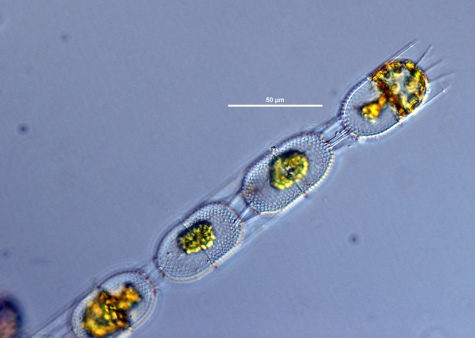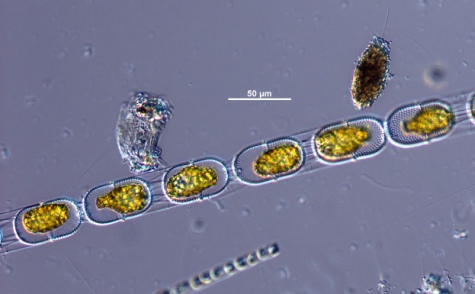



|



|
Synonym(s)
Basionym
The original name for an organism. In botany, the original published nomenclature from which a new binomial nomenclature is derived for a particular group of organisms (Tindall 1999).
(basionym) (Guiry 2011)Classification
(Guiry and Guiry 2012)
Lifestyle
Endogenous
Originating from within an organism. Opposite of exogenous.
"semiendogenous" (Hasle and Syvertsen 1997).Description
Valve
In diatoms, the structurally distinct halves of the cell wall (Becker 1996).
valve surface is covered in coarse hexagonal CloseAreola(e)
In diatoms, the regularly repeated hexagonal holes on the valve walls (HPP 2003).
areolae that are all similar in size. No CloseIntercalary bands
Girdle bands that are furthest away from the valve (Smithsonian 2011).
intercalary bands are present. Adjacent cells are connected by numerous subcentral (not CloseMargin
The outline or border that defines the shape of an organism or cell.
marginal) hollow spines, with a distinct line of fusion between adjacent spines. Spines are also slightly widened at the point of connection. Chloroplasts are numerous and discoid (Cupp 1943). Cells are yellow-brown in colour (Guiry 2012).Cytoplasm
In a eukaryotic cell, a gel-like substance within the cell membrane that contains all the organelles except for the nucleus.
cytoplasm extends into the hollow spines and touches the cytoplasm of the neighbouring cell (Cupp 1943). "Resting spores with thick walls and strong spines at two consecutive ends of adjacent cells" (Cupp 1943).Measurements
Pervalvar axis
The axis through the centre point of the two valves of a frustule. This axis is perpendicular to the valve face.
(pervalvar axis): 20 - 100 μmDiameter (valvar axis): 20 - 90 μm
Areolae: 3.5 - 5 in 10 μm
Close
Labiate process
In diatoms, a simple slit in the valve wall with two internal lips, one on each side of the slit. They can be useful in identification because they are positioned differently in different species (Horner 2002).
Labiate processes: 12 - 16(Cupp 1943, Kraberg et al. 2010)
Similar species
Harmful effects
Habitat
Distribution
Temperate and subtropical species (Cupp 1943).
More abundant in late spring or early summer in Northern European waters (Kraberg et al. 2010). Often forms spring blooms and occasionally present in the summer around the UK (Jones and Spencer 1970).
"Fairly common, but never abundant off southern California and in Gulf of California" (Cupp 1943).
Growth conditions
Environmental Ranges
Temperature range (°C): 6.776 - 21.472
Nitrate (μmol L-1): 0.567 - 9.600
Salinity: 31.144 - 36.128
Oxygen (mL L-1): 5.035 - 7.455
Phosphate (μmol L-1): 0.132 - 1.129
Close
Silicic acid
A general term to describe chemical compounds containing silicon, oxygen and hydrogen with a general formula of [SiOx(OH)4-2x]n. Diatoms polymerize silicic acid into biogenic silica to form their frustules (Azam and Chisholm 1976).
Silicate (μmol L-1): 0.754 - 19.032(OBIS 2012, cited in EOL 2012)
Bloom characteristics
References
Cupp, E. E. 1943. Marine Plankton Diatoms of the West Coast of North America. University of California Press. Berkeley, California. 238.
Encyclopedia of Life (EOL). 2012. Stephanopyxis turris. http://eol.org/pages/910752/overview. Accessed 07 Jan 2012.
Guiry, M. D. 2012. Stephanopyxis turris (Greville) Ralfs ex Pritchard, 1861. http://www.marinespecies.org/aphia.php?p=taxdetails&id=149631. Accessed 07 Jan 2012.
Guiry, M. D. and Guiry, G. M. 2012. Stephanopyxis turris (Greville) Ralfs. http://www.algaebase.org/search/species/detail/?species_id=39724. Accessed 07 Jan 2012.
Hasle, G. R. and Syvertsen, E. E. 1997. Marine diatoms. In: Tomas, C. R. (ed.) Identifying Marine Phytoplankton. Academic Press, Inc., San Diego. 5-385.
Horner, R. A. 2002. A Taxonomic Guide To Some Common Phytoplankton. Biopress Limited, Dorset Press, Dorchester, UK. 200.
Jones, M. and Spencer, C. P. 1970. The phytoplankton of the Menai Straits. ICES Journal of Marine Science. 33(2): 169-180.
Kraberg, A., Baumann, M. and Durselen, C. D. 2010. Coastal Phytoplankton: Photo Guide for Northern European Seas. Verlag Dr. Friedrich Pfeil, Munchen, Germany. 204.
Ocean Biogeographic Information System (OBIS). 2012. Stephanopyxis turris. http://www.iobis.org/mapper/?taxon_id=513734. Accessed 07 Jan 2012.
Poulet, S. A., Cueff. A., Wichard, T., Marchetti, J., Dancie, C. and Pohnert G. 2007. Influence of diatoms on copepod reproduction. III. Consequences of abnormal oocyte maturation on reproductive factors in Calanus helgolandicus. Marine Biology. 152(2): 415-428.
